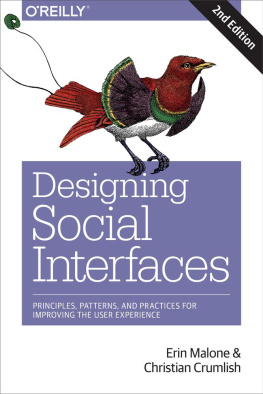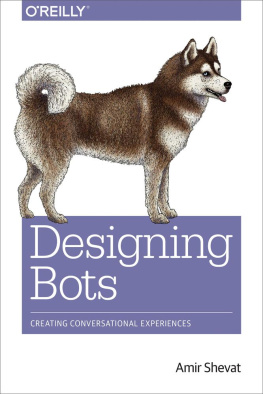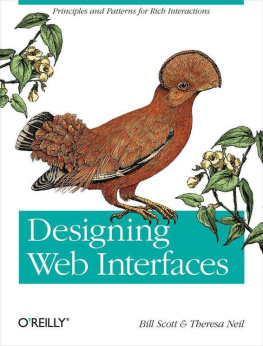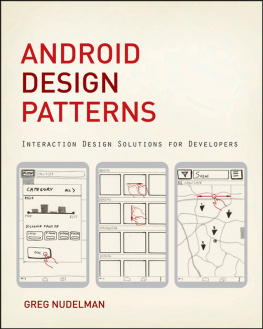Designing Social Interfaces: Principles, Patterns, and Practices for Improving the User Experience
Christian Crumlish
Erin Malone
Beijing Cambridge Farnham Kln Sebastopol Tokyo
Special Upgrade Offer
If you purchased this ebook directly from oreilly.com, you have the following benefits:
DRM-free ebooksuse your ebooks across devices without restrictions or limitations
Multiple formatsuse on your laptop, tablet, or phone
Lifetime access, with free updates
Dropbox syncingyour files, anywhere
If you purchased this ebook from another retailer, you can upgrade your ebook to take advantage of all these benefits for just $4.99. to access your ebook upgrade.
Please note that upgrade offers are not available from sample content.
Praise
Designing Social Interfaces is a fantastic reference for people who want to find the right design patterns fast. If you need to understand how to connect your users to your product and to each other, this book is perfect for you.
LAURA KLEIN AUTHOR, UX FOR LEAN STARTUPS
Chock-full of visual examples, Designing Social Interfaces is a smart and readable reference that will help you apply appropriate design patterns so you dont waste time reinventing the wheel. If youre designing products where people interact with other people, youll benefit from the expertise of these two seasoned practitioners.
KATE RUTTER, UX INSTRUCTOR AND VISUAL THINKING CONSULTANT, INTELLETO
Kids today! They are constantly changing the game on whats considered hot or not in social media. Thankfully Christian and Erin have assembled (and updated!) these powerful models for the social experience, which apply no matter WhatApp people happen to be using these days.
KEVIN M. HOFFMAN, FOUNDER OF SEVEN HEADS DESIGN
A comprehensive catalog of best practices that no UI/UX developer should be without. A highly recommended reference.
MATTHEW RUSSELL, CHIEF TECHNOLOGY OFFICER, DIGITAL REASONING
Preface
Why We Updated This Book
W E WROTE AND DECIDED TO UPDATE THIS BOOK BECAUSE WE NEEDED A BOOK LIKE THIS , and we knew there wasnt one on the market yet. Our own pattern collection, documentation, and arrangement of social user experience interface design patterns grew large and complex enough that we felt it warranted a book-length treatment. We wrote this book to build on the work we were doing at Yahoo! several years ago, and the work of the social design community at large. We wanted to propose a large macro-landscape for organizing and discussing these interaction patterns and to help build a consensus on a common language and set of conventions for discussing social design. We wrote this book because every web designer and developer in the world today is being asked to consider the social dimension of their work, and we wanted to help. We updated the book because in the five years since the first edition, social experience design has evolvedsome things that looked like patterns havent stood the test of time, and some new potential patterns have emerged. Beyond that, mobile has become a major part of the lexicon and new patterns and ways of interacting have become part of the landscape.
What This Book Is About
This book is not about designing social behaviors, although many of the interactions are either dependent on or drive specific social behaviors. Many of the principles in the first section of this book talk about different kinds of user behavior, but are best considered across the landscape of the entire pattern collection.
This book is about interaction design , specifically designing social interactions and interfaces on the Web and in mobile environments. The collection of patterns is a distillation of many years of experience in designing social and community products for the Web and mobile devices that have led us to define this set of best practices, principles, and patterns for social interfaces. We focus on consumer-facing interactions, primarily because thats where our experience lies. We have expanded the enterprise and mobile coverage; remember that all the patterns can be applied in the enterprise and in devices, provided the problems and solutions are viewed with the appropriate lens and set of constraints.
This collection is emerging, evolving, and continues to grow with time and technical innovations.
The Visual Examples
In the first edition, we referred to Yahoo! in many examples because we had developed many of the patterns in the context of designing products and features across the Yahoo! network. The patterns were tried and tested across hundreds of millions of users. In the second edition, we have tried to include visual examples from many sources around the Internet to illustrate the interactions of various patterns (and pieces of patterns), and to leverage the past several years of experience and growth across the social landscape of software. They say a picture is worth a thousand words, so wherever possible, we try to show how something can be accomplished instead of just talking about it.
How This Book Is Organized
This book is organized into five parts. The first introduces the concept of user interface design patterns and outlines some high-level principles for social design that we believe inform all the subsequent patterns. The next three parts each introduce a major cluster of related patterns, grouped together by theme. The final part explores some emerging considerations that have not yet attained the status of patterns but warrant close attention.
Part I: What Are Social Patterns?
In , we cover some of the broad, overarching principles that can make the difference between a successful, thriving online community and a ghost town.
Part II: I Am Somebody
One of the building blocks of social experiences are representations of individual people in the system. Just as in Monopoly , each player needs a token that represents him in the game. presents a family of reputation patterns that can help encourage the sort of behaviors you wish to foster.
Part III: The Objects of Our Desire
This is the largest chunk of the book, where we get into the actual behaviors that people engage in online and introduce the concept of social objects: those conversation pieces that anchor and give meaning to social interactions online. takes a step back to discuss larger social media ecosystems and interfaces that help people make sense of them.
Part IV: A Beautiful Day in the Neighborhood
The third cluster of patterns addresses relationships and the communities that can grow out of them. explores how to enable people to meet one another in the real world and create shared events.
Part V: Closed and Open Social Networks
In the final part, we approach the leading edge of social design and discuss some of the considerations you may encounter there. In , we look to social in the enterprise.
Sidebar Essays
Just as we have approached the collection of patterns as both authors and as curators of information from many sources, we have curated a collection of different voices from around the Internet to share alternative opinions, more in-depth exploration, and thoughts about social user behavior that provide seasoning around the patterns in each chapter. Look for continued conversations on these topics on our wiki and on the individual essayists personal blogs.












